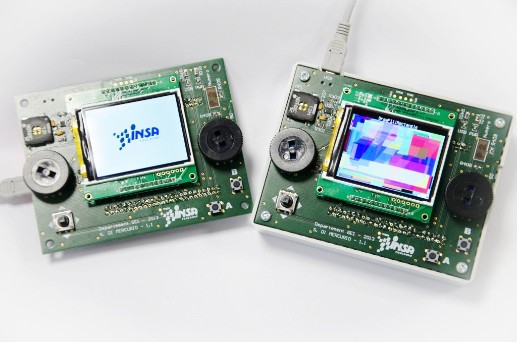The GEI’s video-game consoleADA programming on embedded systems

A new programing and algorithmic approach
Until 2014, the “Algorithmic and Programming – Operating systems” UF practical teaching in 2IMACS was based on the use of a PC for the program execution. Students developed their algorithms and tested them in ADA on a PC.
In order to actualize this teaching, we offer since 2015 to the students to acquire the same skills but as part of the embedded systems through the use of circuit boards equipped with microcontrollers.
Targeted skills
The skills concern:
- A complex issue analysis
- The design of a program based on algorithms (possibly recursive) and a coherent breakdown into sub-programs,
- The choice of data structures adapted to the problem among constrained and non-constrained tables, articles and linked lists,
- The implementation of the programme and the writing of the associated tests.
This evolution also allows to broach the target performance limitation problems, and to bring the basics of the entry and exit concept digital or analogical linked to embedded systems.

The video-game console architecture
The video-game console system developed by S. DI MERCURIO is based on a “Discovery” F3 STM32 circuit board, including different sensors such as an accelerometer, a gyrometer, a magnetometer, with an interface card developed at INSA.
The console allows to simulate a small video-game console, with a screen, audio system, potentiometer and keys, and an interface for a micro SD card and the communication with a PC via an USB port. About one hundred video game console copies are in service since 2015, thanks to a STPI’s funding.
Practical works’ topics
The practical works’ topics (G. AURIOL’s page) cover the following aspects:
- Development of a “Pacman” program with the management of labyrinth posting, movements, number of lives, contacts with the walls and timer.
- Development of a “Snake” program with accelerometer commanded movements
- Design of an efficient algorithm to search for a value in a classified table
- 3 axis magnetic field sensor management (P. ACCO’s page)
Feedbacks
The teaching team has collected a first very positive feedback from the students. Some of them, particularly motivated wish to have available some cards to end their practical work or to go further, outside the supervised practical work as the platform has a definite pedagogical and playful character. The teaching team is studying card lending solutions based on an existing student structure, for example.

